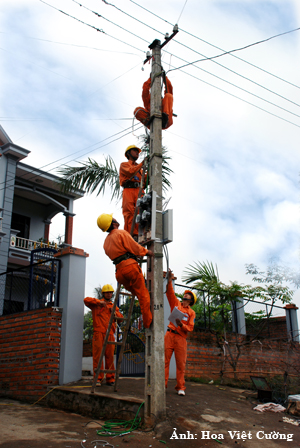 Most are overloaded
Most are overloaded
According to the latest survey on the status of the grid in Hanoi of City People's Committee, since early 2009, many 220kV stations have been overload and do not have enough backup power in case of breakdown, greatly affecting the safety of power supply. To prevent 220 kV stations from being overloaded, the Electricity of Vietnam (EVN) has invested in increasing the capacity for three 220kV stations of Chem, Ha Dong and Mai Dong, temporarily solving the unstable power supply for Hanoi in 2010-2011.
Besides, currently, the reliability of the 220kV grid system is not high. Although 220kV stations get power supply from two lines, power supply radius of the stations is long and the section of the line is not big enough, so when breakdowns happen to one line, the other one could be overloaded. In addition, there has been no connection among the 220kV gridlines supplying electricity to the areas of left and right banks of the Red River, so the power supplies for Hanoi from both sides can not support each other when one source is deficient.
Regarding the 110kV power transmission system, People’s Council assessed that most lines have been fully loaded, especially the central area. Thus, any breakdown will cause serious overload, leading to widespread power outages. To prevent overload, most of the 110kV lines are uncovered, causing great loss and lowering reliability. Currently, the electricity industry has improved section, installed temperature superconducting wires for 110kV lines following 220kV expanded stations (Chem, Ha Dong, Mai Dong) to exploit the full capacity of 220 kV stations and prevent overload for 110kV lines.
Enough power for development
According to Vice Chairman of Hanoi People's Committee Nguyen Huy Tuong, socio - economic development target of Hanoi in 2011-2015 is to maintain an average GDP growth rate of 12-13% per year and 9% per year in the period of 2016-2020. To ensure this rate, one of the most important factors is to ensure the safety and stability of electricity supply. Accordingly, it has been forecasted that, in 2015, the demand for commercial electricity of the city shall be about 16.513 billion kWh; the growth rate in 2011-2015 shall be 12.6% per year, equivalent to 2,220 kWh/person/year . By 2020, commercial electricity shall reach 27.753 billion kWh, the growth rate in the period of 2016-2020 shall be 11.4% per year, equivalent to 3,488 kWh/person/year.
Under the scheme which has recently been approved, the total investment capital for power development of Hanoi up to 2015 is VND 19,481.1 billion. In particular, VND 5,981.4 billion shall be invested in 220 kV grid; VND 4,993.9 billion in 110kV grid and high voltage compensation devices; VND 6,568.9 billion in medium-voltage grid; VND 1538.7 billion in low-voltage grid and VND 398,1 billion in new renewable energy. Investment capital for developing power grid is mainly the capital of Vietnam Electricity Corporation and other electric trading organizations ... The city will renovate low-voltage lines and improve the quality and the load capability of 1.027km of line. Also, 2.635km of low voltage line shall be constructed and 1,346,530 meters shall be installed.
Answering questions about whether the power development plan of Hanoi is compatible with the Capital development master plan, Mr Nguyen Huy Tuong said that the electricity planning agency often work with master plan agency to update information. Therefore, electricity planning will ensure compatibility with the master plan. Also according to Mr. Nguyen Huy Tuong, besides the power supply from factories, Hanoi has paid attention to renewable energy and new energy sources. Regarding underground medium voltage grid, Hanoi aims to the rate of 35-40% in the whole city and 90-100% in the central area by 2015...